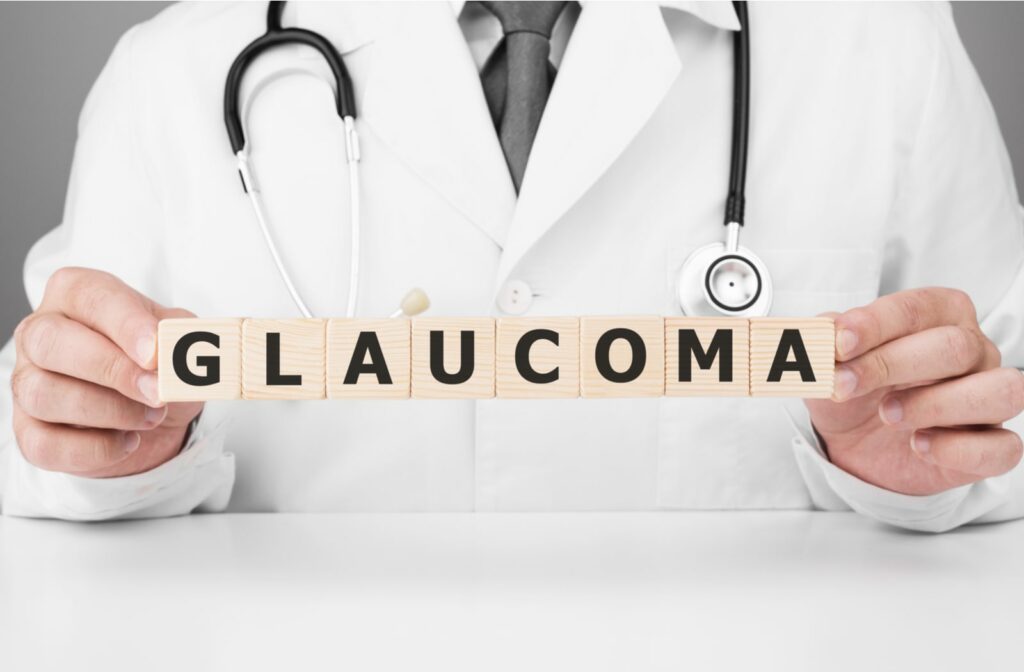Glaucoma is a common eye disease that affects millions of Americans. It’s most commonly associated with age. But young adults, children, and even infants have been diagnosed with it.
There are often little to no symptoms when glaucoma begins. Regular eye exams are vital in its early detection and treatment. Once glaucoma causes the damage, it cannot be fixed. However, early treatment can slow the disease and prevent vision loss.
The goal should be to prevent symptoms of glaucoma from ever surfacing. But if they do, it’s essential to see your optometrist as soon as possible.
What is Glaucoma?
There are several different types of glaucoma, but all of them are eye conditions that damage the eye’s optic nerve. The damage is often linked to a buildup of intraocular pressure. But it can also come from external damage to the eye.
Common Types of Glaucoma
- Open-angle (wide-angle): Our eyes have a drain structure called the trabecular meshwork. If this is fine, but your eye won’t drain fluid as it’s supposed to, the pressure builds up and damages the optic nerve. This is the most prevalent type of glaucoma.
- Angle-closure (acute-angle): With angle-closure glaucoma, the area separating your iris and cornea becomes too narrow and doesn’t allow the eye to drain. And this causes a rapid buildup of pressure that damages the optic nerve. This glaucoma is less common in North America.
Rare Types of Glaucoma
- Normal-tension: If your eye pressure stays within the normal range, but your optic nerve sustains damage, the optometrist may diagnose this type of glaucoma.
- Secondary: Sometimes, other conditions such as cataracts or diabetes cause intraocular pressure. Optometrists refer to this as secondary glaucoma.
- Pigmentary: In some cases, tiny pigment particles from your iris mix into the fluid. If they clog the trabecular network, it stops your eye from draining properly.
Symptoms of Glaucoma
The main danger of glaucoma—other than the eventual vision loss—is that until the disease is advanced, it often doesn’t present with any symptoms. This is especially true if you’re suffering from open-angle glaucoma.
The onset of symptoms from angle-closure or acute-angle glaucoma is typically much faster and more noticeable.
If you notice any of these symptoms or combinations of them, it’s important you visit your optometrist right away for an eye exam.
- Vision loss: Regardless of the cause, it’s an emergency if this happens.
- Hazy-looking eyes: This is a common glaucoma symptom in infants.
- Severe Eye pain
- Red eyes
- Halos surrounding lights
- Headaches
- Upset stomach and puking: Although it could be a bug, if other symptoms of glaucoma accompany this, it could be connected.
Increased Risk Factors for Glaucoma
In addition to the genetic factor, several things can put you at a higher risk of getting glaucoma.
- High intraocular pressure
- Thin-centered corneas
- Certain ancestries are more susceptible
- Family history
- Age: 60+
- Underlying medical conditions like high blood pressure or diabetes
- Severe eye injury or eye surgery
- Long term use of corticosteroid eye drops
Prevention and Treatment of Glaucoma
There are several things you can do to prevent glaucoma from becoming a problem in your life. The first and best way is through regular eye exams. The earlier that an optometrist can diagnose glaucoma and begin treatment, the better the odds that the treatment will prevent vision loss.
In addition to eye exams, protecting your eyes from physical damage eliminates one possible source of glaucoma.
Treatment
Once your optometrist diagnoses you with glaucoma, their recommended treatment may vary depending on the severity and cause of the disease. Some possible treatments include:
- Medicated Eye Drops: Your optometrist can prescribe several types of eye drops. Each of them aims to lower your eye pressure to prevent any further optic nerve damage.
- Medication: Similar to eye drops, there are oral medications that you can take to achieve the same results. Remember, with eye drops and oral medication, it’s important to let your optometrist know if you take any other medications to prevent adverse reactions.
- Surgery: There are several laser surgery options available for glaucoma treatment. In addition, an ophthalmologist can perform a microsurgery procedure called a trabeculectomy. Essentially, the doctor creates a new route for your eye to drain.
Living With Glaucoma
Although there is no curing glaucoma, there are things you can do to contribute to a comfortable life and help improve your eye health.
- A healthy lifestyle is good for overall health—eyes included. This means staying active and eating healthy.
- If your optometrist prescribes medication or special eye drops, ensure you’re taking them even if you feel like you don’t need to.
- Curbing habits like smoking or excessive caffeine intake will help keep your blood pressure in check, which will specifically help with the symptoms of glaucoma.
- Avoid or cut back on anything that creates a lot of blood flow to the head, like some yoga positions, for example.
- Protecting your eyes is always important. But if you have glaucoma, take extra precautions to protect your eyes from the sun and glaring surfaces like snow or water.
Closing Thoughts
The only way to confirm whether or not you have glaucoma is with an eye exam. If you have some of these symptoms and your “scheduled” visit isn’t anytime soon, contact us today, and we can discuss getting you in as soon as possible.



